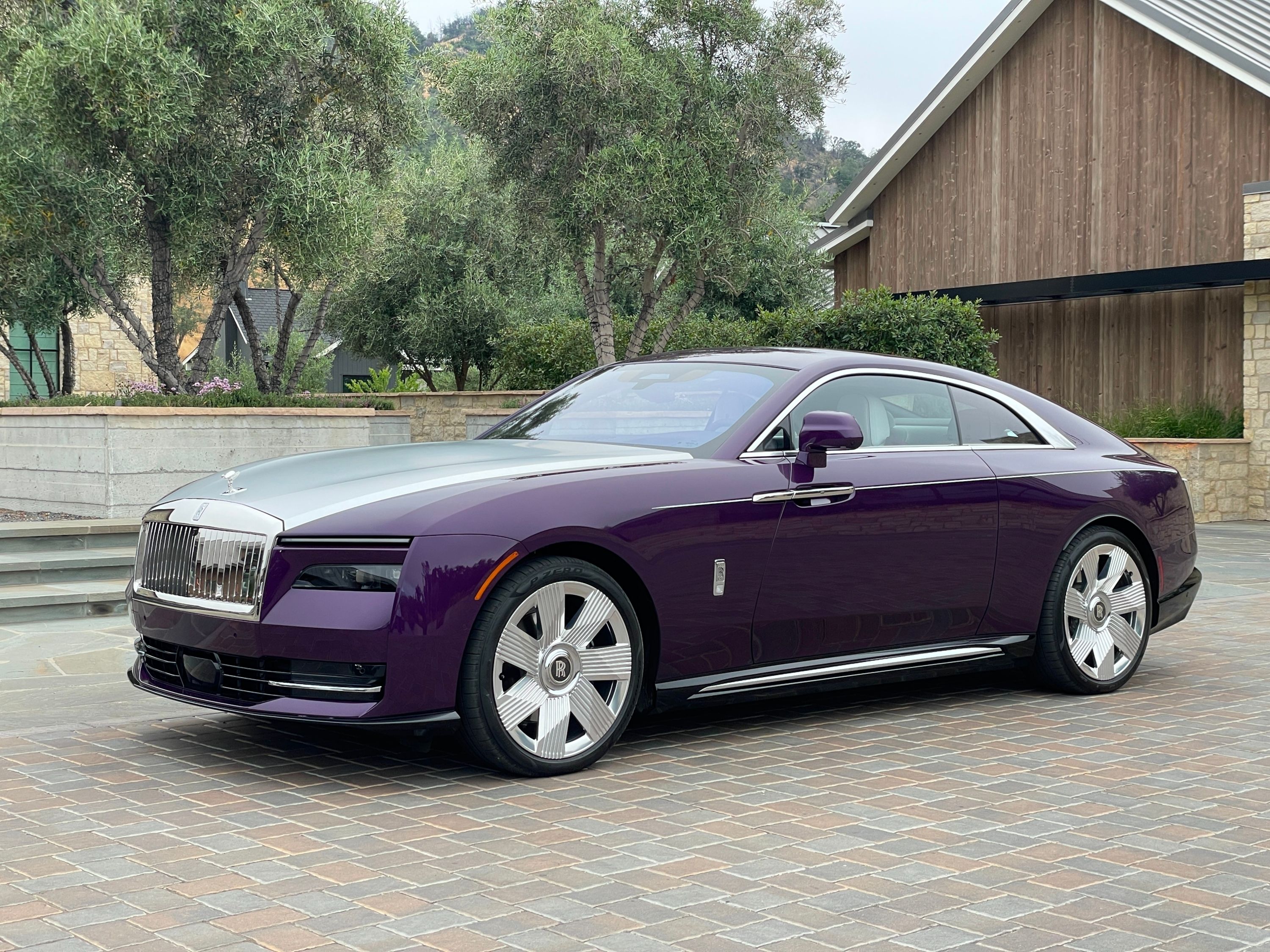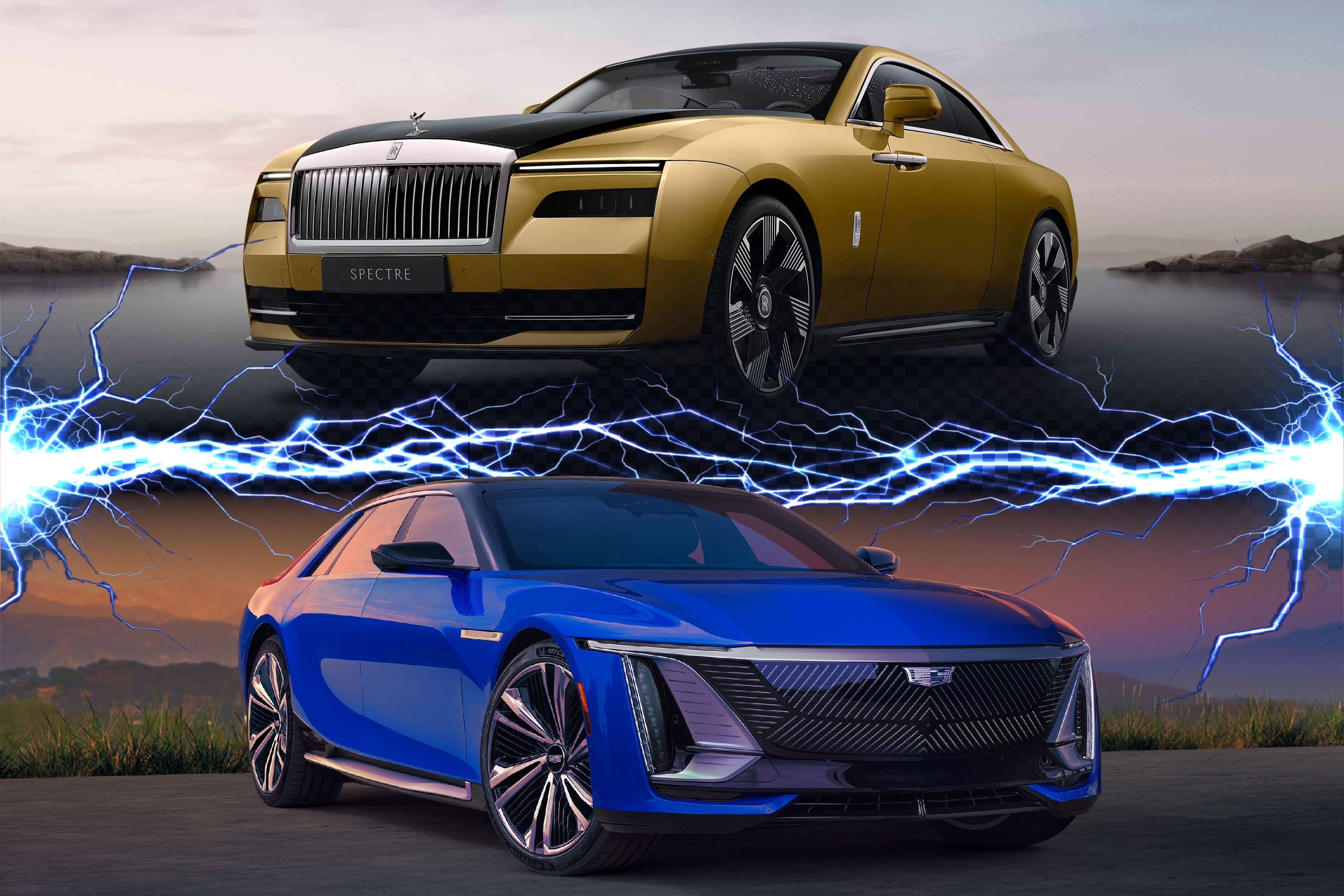
Let's start by stating that these two cars aren't apparent rivals. One has four doors and a fastback-like profile while the other is a coupe. Besides that, Cadillac Vs. Rolls-Royce comparisons are almost non-existent, except as a joke. Still, there are obvious similarities. Both are hand-built EVs that cost more than $300,000. Now that Bentley's own EV has been pushed back, these two will likely remain the only competitors in their admittedly tiny segment for quite some time.
And don't even mention cars like the BMW i7 and Mercedes-Benz EQS. They're way too cheap to be considered in this company, where the high asking price is undoubtedly part of the appeal.
This is a showdown between the Cadillac Celestiq and the Rolls-Royce Spectre, the only options in the ultra-luxury EV segment.
Exterior: Familiarity Vs. Quasimodo
Beauty is in the eye of the beholder, but there's a clear winner here.
The Rolls-Royce is different but familiar. The side profile, grille, and headlights are familiar but slightly updated to let you know that this Roller is powered by volts. The Spectre has the widest Pantheon grille ever fitted to a Rolls-Royce, and the vanes are smoother and backlit for added visual drama. A set of 23-inch wheels is standard, just in case a passer-by doesn't notice any other design features, including a more aerodynamically efficient Spirit of Ecstasy.
We don't think the colors on this example work particularly well but imagine, for a moment, a light blue model with the same contrasting black hood and roof.
What more can we say about the Celestiq's design? It's pretty at the front and, uhm, interesting at the rear.
We love that Cadillac is using real brushed aluminum and metal for the exterior adornments, and the large smart glass roof looks epic. An apparent fusion of wagon, sedan, and fastback, the Celestiq has a long, flowing roofline. There's something odd about it, though, and we think we know what it is. If you remove the stretched taillights and lift the end of the sloping roofline up by three to four inches, it would look epic. Then again, Cadillac has succeeded in penning a true head-turner, and that's important in this segment.
Both cars have unique doors. In the case of the Spectre, these are coach-style items that can be optioned with softly illuminating stars inside, while the Celestiq has no door handles at all - the doors always open and close automatically. Yes, even the act of entering and exiting these EVs promotes a sense of occasion.
Performance: Not As Shocking As You Might Think
You can get the 1,200-horsepower Lucid Air Sapphire for a lot less. It will sprint to 60 mph in less than two seconds, leaving both these luxury barges in its dust. But that's not what luxury motoring is about.
We can't think of a better segment of cars suited to electrification. An EV motor is near silent, silky smooth, and provides all its torque almost immediately. Luxury automotive manufacturers have tried for years to get NVH levels down to zero, and electrification is the ultimate solution.
In both cases, the goal here was to deliver effortless acceleration, not the kind of 0-60 mph time that will spill champagne all over the expensive interior.
So the Caddy has a dual-motor setup, producing a GM-estimated 600 hp and 640 lb-ft of torque. Rolls-Royce uses the same format but produces even less power. The Brits give you 577 hp but more torque at 664 lb-ft. The Caddy hits 60 mph in a projected time of under four seconds, while the Roller takes 4.4. Nothing matters less than these two figures.
In both cases, the powerful motors have to contend with extremely heavy curb weights. We don't know what the Celestiq weighs, but the Spectre comes in at an astounding 6,559 lbs.
Range, Battery, And Charging: Not A Problem
Let's get an obvious solution out of the way real quick. If you can afford one of these cars, there's a good chance you can afford a high-tech home charging setup. We happen to know that it costs around $120k to build a Tesla Supercharger Station, so why not invest that money now that the American EV builder is finally opening its network to other EVs?
The Celestiq has a 111-kWh battery and is equipped with 200 kW fast charging, which can add 78 miles of range in 10 minutes. The estimated driving range is 300 miles, so it needs roughly 40 minutes for a full "tank" of electricity.
Rolls-Royce did not say how big the Spectre's battery is, but it stated that the car should be able to cover 260 miles when fully charged. Rolls also failed to provide charging times, but they should be similar to the BMW i7. Using a 195-kW fast charger adds 80 miles of range in 10 minutes.
Also, if you're going to be traveling further than 300 miles, just use your other car.
Interior: Caddy Has To Bring It
Going toe-to-toe with the masters of high-end interiors will not be easy.
Obviously, both cars are loaded with all the luxuries you could want and a selection of screens. The Caddy even has a 55-inch screen that stretches from pillar to pillar, but that's not true luxury. It's about fit and finish, quality materials, and a general sense of well-being.
Both cars use the finest materials. In fact, Cadillac uses advanced 3D printing technology to create intricate metal inserts that can't be made using traditional methods. Caddy also uses other modern tech to enhance the luxurious ambiance. The fixed glass roof uses Suspended Particle Device technology to control how much light enters the cabin. The cabin also has a built-in noise-canceling system to help the hundreds of pounds of sound-dampening material.
As with the Rolls-Royce, you can select almost any exterior and interior color, and only the finest leathers, wool, and metals are used to create the interior.
What more can we say about Rolls-Royce interiors? The interior of this particular Spectre is horrible, but at least it shows the level of customization available to customers. The famous Starlight roof is carried over from other models, and even the doors are adorned with 4,796 individual lights.
Spectre buyers will have access to Rolls' existing Bespoke Division and endless possibilities. The dashboard and fascia are familiar, but the front seats are new. Rolls-Royce obviously believes that many of its existing clients will buy a Spectre in addition to whatever Roller they already have in the garage.
The Caddy may have an edge in rear-seat space since it has dedicated rear doors, although at 214.7 inches in length, the Rolls-Royce is incredibly long for a two-door car.
Pricing And Verdict: Does It Matter?
Cadillac has not committed to a specific price yet but has stated that buyers can expect a starting price north of $300,000. Once you add more premium options, it will likely be easy to hit $400k. Pricing for the Spectre starts at $413,000, but we can guarantee that not a single model will be sold at that price.
In this segment, it's not a matter of choosing A or B. You don't buy a car instead of something else, you buy this kind of car in addition to something else. We can easily see a customer purchasing the Caddy for the week and the Roller for the weekends.
Price is irrelevant, but the buying experience and after-sales service are essential. As we know, Rolls-Royces are hand-built in Britain, and its customers are treated like royalty.
Cadillac will try and mimic this business model by hand building the Celestiq at the General Motors Global Technical Center in Warren, Michigan. Warren doesn't sound as upmarket as Goodwood, but we'll reserve comment until we've experienced both cars in person.
If you can't wait that long, order both now and see which works better for you.

